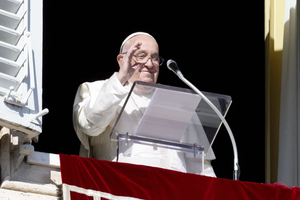Fascinating Facts: Discover More About 7 Beloved Holy Men and Women
Little-known and surprising trivia are at the ready to discover.

In All Saints’ Day, the faithful honor all of heaven’s saints. There are myriad popular saints. But even well-known saints can be more known, with little-known and surprising trivia at the ready to discover. Here is a sampling.
St. Faustina Kowalska, best known for her promotion of the Divine Mercy devotion, also received apparitions of the Blessed Mother and St. Joseph, for whom she had great devotion. She wrote of one appearance: “St. Joseph urged me to have a constant devotion to him. He himself told me to recite three prayers [the Our Father, Hail Mary and Glory Be] and the Memorare to St. Joseph once every day. He looked at me with great kindness and gave me to know how much he is supporting this work [Divine Mercy]. He has promised me this special help and protection. I recite the requested prayers every day and feel his special protection.”
St. Louis de Montfort, the great apostle of the Rosary and the 33-day consecration to Jesus through Mary, also carved Marian statues. Three are in the Marian Collection at the University of Dayton in Ohio. One is titled Notre-Dame de la Sagesse (Our Lady of Wisdom), a polychromed wooden statue. He depicted Mary in a gold robe with blue veil decorated with fleur-de-lis. She is shown carrying a globe-holding Child Jesus. The other two carved statues, both of natural wood, present Mary also holding the Child Jesus: The Virgin and La Dame Blanche de Landemont (The White Lady of Landemont). During his ministry, he restored several chapels and commissioned sacred art. In early years he also painted some smaller devotional pictures.
St. Louis de Montfort, known for his entrustment to Our Lady, Totus Tuus ego sum, from which Pope St. John Paul II got his motto, also predicted his Marian masterpiece, True Devotion to Mary, would be hidden for years. “I clearly foresee that raging beasts will come in fury to tear to pieces with their diabolical teeth this little book and the one the Holy Spirit made use of to write it, or they will cause it at least to lie hidden in the darkness and silence of a chest and so prevent it from seeing the light of day. They will even attack and persecute those who read it and put into practice what it contains. But no matter! So much the better!
“It even gives me encouragement to hope for great success at the prospect of a mighty legion of brave and valiant soldiers of Jesus and Mary, both men and women, who will fight the devil, the world and corrupt nature in the perilous times that are sure to come.”
Indeed, the work lay hidden for nearly 150 years. During the French Revolution, the congregation he founded, the Company of Mary, gave his and other works to local farmers to bury for protection as civil authorities searched to destroy religious works.
After the Revolution, the documents were found and returned to the company’s motherhouse. There they sat for more than a hundred years until, in 1842, a priest-librarian came upon their founder’s manuscript. He said he “recognized the style and thoughts of our venerable founder.” Identifying the handwriting, the superior announced, “We have found a treasure!” True Devotion to Mary has been in constant publication since 1843.
St. Thérèse of Lisieux, the Little Flower, who showers the faithful with roses from heaven, wrote, produced and acted in convent plays called “pious recreations,” such as Joan of Arc. She was also a gifted artist and poet. The Carmel of Lisieux (Archives-Carmel-Lisieux.fr) is guardian of her poems, drawings and liturgical artistry. The collection includes several pencil sketches she drew as a young girl, such as rural scenes and a country church. The variety of her artistry includes a pair of plaster angels, measuring more than 2 feet tall and adorned with pink and blue robes and a profusion of flower petals like crosses, all trimmed in dazzling gold; a statue of St. Germaine de Pibrac; and a very moving rendition of the Pietà.
St. Francis de Sales, bishop of Geneva, doctor of the Church and author of the timeless masterpiece An Introduction to the Devout Life, was the first saint to be solemnly beatified in St. Peter’s Square. The patron saint of journalists invented “flyers” and “posters,” which he delivered to houses and posted in public places to draw those fallen away during the Reformation at the height of Calvinism to hear his sermons and return to the Church. And they did come back — in droves. It was his example that showed the way to holiness for other saints, including Jane de Chantal, John Bosco, Dominic Savio and Alphonsus Liguori.
St. Alphonsus Liguori also became a bishop and doctor of the Church. A prolific writer, he founded the Redemptorists. He also had great musical talent. When Alphonsus was a child, his father had him practice the harpsichord three hours a day. He became a master of the harpsichord and continued to play it in his later years, accompanying the novices in his community as they rehearsed hymns that he also composed.
St. Mary Magdalene is last seen after the Resurrection when Jesus appears to her. But what happened to her afterward?
Tradition tells how she, Martha, Lazarus and some companions set out to sea on a boat, with no oars or sails. Providentially, they arrived in France and traveled through Provence converting the local people. Mary Magdalene went on to Sainte-Baume where, in a hillside cave, she lived as a hermit in penance and prayer for the rest of her life.
At the end of her life, it is believed angels carried her to Aix-en-Provence, where she received Viaticum from St. Maximin, also a disciple of Jesus, then died in his arms and was buried in an oratory named for St. Maximin.
From early centuries, monks sought out the Grotto of Sainte-Baume. Returning from the Crusades, St. Louis, king of France, came with his knights there first. In 1279, Charles II found Mary Magdalene’s shrine and relics. Rome declared them authentic, and Clement VIII sent a sarcophagus for them. Mary Magdalene’s head is now housed in Sainte-Baume.
Blessed Carlo Acutis was known for his skill as a computer programmer and web designer and was also a self-taught saxophone player. He also played soccer and was known for his kind heart, always quick to defend schoolmates, especially children with disabilities who were being picked on. As CNA reported, “When a friend’s parents were getting a divorce, Carlo made a special effort to include his friend in the Acutis family life.”
All you holy men and women, pray for us!
- Keywords:
- all saints' day
- catholic saints
- joseph pronechen

















